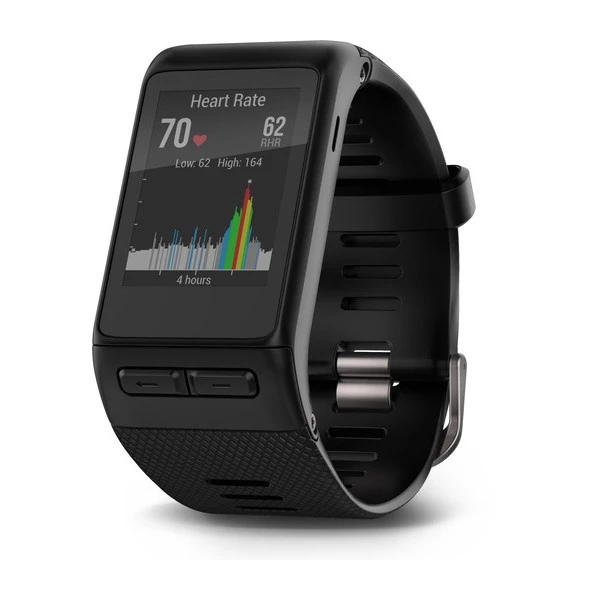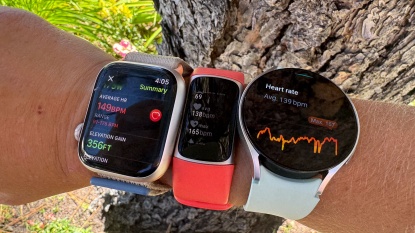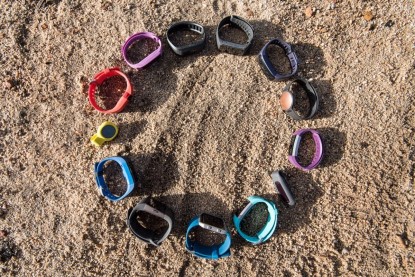Garmin Vivoactive HR Review
Our Verdict
Our Analysis and Test Results
This product has a built-in GPS module and an optical heart rate sensor packed into a tiny package. While it is a little bit on the bulkier side and doesn't have that long of a battery life compared to non-GPS models, it also has an absolutely astonishing array of additional sensors crammed in its decently small profile, such as a barometer, altimeter, accelerometer, and a thermometer. This model is also compatible with plenty of other Garmin products, allowing it to be used as a remote for the VIRB action cameras or feed data to a head mounted cycling display.
Performance Comparison
To evaluate the performance of each of these fitness bands, we bought all of the top models available on the market today and put them through a comprehensive series of side-by-side challenges to push them to their limits and see which models came out on top. We conducted over 25 different tests in totals, divvied among five weighted metrics — Fitness Impact, Health Impact, Ease of Use, Ergonomics, and Display — each weighted proportionally to their significance.
Fitness Impact
Unsurprisingly, the Fitness Impact rating metric merited the most weight of any metric in our review, comprising 30% of the total score for each fitness band. This metric is made up of an evaluation of the step accuracy of each tracker, how well it estimated distance, what activities it can track and what data it provides, as well as if it can calculate the number of flights of stairs climbed throughout the day. The Vivoactive HR scored very well in this metric, earning an 8 out of 10 for its superb performance.
This model's step counter proved to be highly accurate in our tests, only having an average deviation of about 10 steps or 0.47% on a mile-long walk when compared to our manual count with a mechanical tally counter. However, this model didn't do the best at estimating true distance traveled — even with the GPS — showing a track of 1.08 miles, when our course was exactly a mile, measured by a surveyor's wheel.
This model did have an excellent suite of features for tracking a cycling workout, displaying your top speed, average speed, distance traveled, time, and elevation changed, as well as calories and heart rate. One feature that we particularly like was that all of this information is shown on the tracker itself, rather than requiring you to open up the companion app.
Overall, we found this product to give the most detailed set of stats of any of the models that we tested. It will provide a similar set of information when tracking a workout, as well as the applicable stats for its exceptionally large set of trackable activities.
These include, but aren't limited to, swimming, skiing, SUP, XC ski, running, indoor rowing, pilates, gymnastics, and golf. Finally, this model does keep track of how many flights of stairs you climb a day, though it did miss one flight in our testing process.
Health Impact
Ranking second in terms of significance, our Health Impact metric accounts for 25% of the overall score for each product. We evaluated the accuracy of the heart rate sensor when compared to a chest band, how much motivation the fitness tracker is able to provide you to get up and get active or stick to a diet, and if it had sleep tracking capabilities and a vibration alarm clock. The Vivoactive HR did decently well in this set of tests, earning a 7 out of 10.
This model scored very well in our heart rate test, almost exactly matching the chest strap when measuring a resting heart rate. However, it was a little less accurate when measuring an active heart rate in our tests, averaging about 8 bpm off of the chest strap.
This model of fitness tracker or its companion app don't really have any method to help you maintain a diet and count caloric intake, instead relying on the third-party MyFitnessPal app. However, it does keep a tab on the calories you burn throughout the day, both active and RMR (Resting Metabolic Rate). The Vivoactive HR does do a great job at helping you get up and get moving, with vibration alerts when you have been still for too long and a movement bar that will build up the longer you have been sitting. It takes a proportional amount of activity to reduce the bar back to zero.
This model does have a vibration alarm clock and the ability to track your sleep, but we struggled with it slightly, only getting it to properly record on our third night with it.
Ease of Use
Making up 20% of the total score, our Ease of Use metric encompassed testing the battery life of each product, how quickly it could sync its data to the app, the ease of navigating the menus on the device and using the app, as well as how much work it was to put the fitness tracker on and off and if it is water resistant. The Vivoactive HR scored alright in this metric, earning a 6 out of 10 for its slightly above average performance.
This product has a relatively average battery life, lasting for a claimed 8 days in “Smart Mode” and for 13 hours when in GPS mode. It takes a little time to send a day's worth of data to your mobile device, anywhere from 5-15 seconds — longer than the Fitbit brand models. The Vivoactive HR uses the Garmin Connect app. This companion app isn't our favorite, being a little less intuitive and harder to use than others we looked at, but it's a decent app on the whole.
It's relatively easy to navigate between menus on the device, with a touchscreen interface in addition to two buttons underneath the screen. The only real quirk we found is that there is a difference between holding and tapping the buttons in terms of navigations. The Vivoactive HR is also waterproof to 5 ATM — a necessary match to its swim and paddling tracking capabilities.
It is also very easy to put this fitness band on, with its watch-style clasp, though the retaining clip can be a little fickle.
Ergonomics
Our Ergonomics metric consisted of evaluating the comfort of each fitness tracker, how much it protruded from your wrist, as well as its overall aesthetics. This band didn't score particularly well, again earning a 6 out of 10 for its performance. The following graphic shows how this ranks with the rest of the group.
The Vivoactive HR definitely isn't the most comfortable fitness tracker that we have tested, feeling a little bulky on the wrist due to its size. It has a relatively low profile and hugs your wrist tightly, but there is no getting around its heft. It's also quite generic in terms of looks — a flattened black plastic rectangle with a few curves. It doesn't look bad, but it definitely isn't trying to make any statements.
Display
Finishing out our review, we looked at the display of each product. We compared the visibility in bright and dim lighting conditions, how responsive the touchscreen is, and what information and notifications are displayed on the home screen. The Vivoactive HR finished out with a solid score of 9 out of 10 — one of the top models of the bunch.
The Vivoactive HR displays the time and date on the front face, as well as giving you the option to create your own customized watch faces. The screen is exceptionally easy to read — even in bright outdoor lighting conditions. The touchscreen is also highly responsive to commands and the tactile buttons work very well. You can also receive a handful of notifications on the device, such as text, call, email, and app push notifications. Further displays off of the home screen also show your basic fitness stats for the day.
Value
The Vivoactive HR is a premium fitness tracker at a premium price. It can occasionally be found on sale, making it a decent value when the sale is occurring.
Conclusion
The Garmin Vivoactive HR is a fantastic pick if you have a whole host of activities that you are trying to track. It's a little on the bulky side, so you should look elsewhere if you want a more petite or discreet model, but the Vivoactive HR is your best bet if you want to take a fitness tracker on your more extreme outdoor activities, compared to a daily walk or run.
















